

Seth Cable Introduction to Linguistic Theory Spring 2018 Linguistics 201 Some Optional Practice on Allophonic Rules The following are some optional problems in finding allophonic (phonological) rules. They are intended to help you practice for Assignment 5 (which will be assigned on March 5 th ). (1) Oral Stops in Zoque Consider the following words of Zoque, a Mixe-Zoquean language of Mexico: [kenba] ‘he sees’ [ndzin] ‘my pine’ [nd ʒ ehtsu] ‘you cut’ [pama] ‘clothing’ [mi ŋ ge ʔ tu] ‘he came also’ [mbama] ‘my clothing’ [t ʃ eht ʃ axu] ‘they cut it’ [ngenge ʔ tu] ‘I also saw it’ [and ʒ i ʔ u] ‘goatee’ [p ə nda ʔ m] ‘men’ [petpa] ‘he sweeps’ [wixta] ‘he walked’ [mja ŋ damu] ‘you went’ [t ʃə kna ʔ t ʃ ] ‘my pine’ Show that [ b ] and [ p ] are allophones of the same phoneme. a. Question 1: Show that [ t ] and [ d ] are allophones of the same phoneme. b. Question 2: Show that [ g ] and [ k ] are allophones of the same phoneme. c. Question 3: Note: For this problem, treat [ d ʒ ] and [ t ʃ ] as sequences of phones, rather than as single affricate phones. 1
Seth Cable Introduction to Linguistic Theory Spring 2018 Linguistics 201 (2) Stops and Affricates in Brazilian Portuguese Consider the following words from Brazilian Portuguese (the dialect of Portuguese spoken in Brazil). [tenu] ‘I have’ [tal] ‘such’ [natu] ‘born’ [kuat ɹ u] ‘four’ [uta ɹ ] ‘to annoint’ [t ʃ ivi] ‘I had’ [t ʃ iu] ‘uncle’ [pat ʃ ina ɹ ] ‘to skate’ [pa ɹ t ʃ i] ‘party’ [pet ʃ i] ‘comb’ [dadu] ‘given’ [mad ɹ ina] ‘godmother’ [mode ɹ nu] ‘modern’ [unidu] ‘united’ [gua ɹ da] ‘guard’ [d ʒ inei ɹ u] ‘money’ [od ʒ iu] ‘hatred’ [v ɛɹ d ʒ i] ‘green’ [v ɛɹ dad ʒ i] ‘truth’ [g ɹ ad ʒ i] ‘big’ [eu] ‘I’ Show that [ t ] and [ t ʃ ] are allophones of the same phoneme. a. Question 1: Show that [ d ] and [ d ʒ ] are allophones of the same phoneme b. Question 2; Note: For this problem, treat [ d ʒ ] and [ t ʃ ] as single phones (affricates), rather than as sequences of two phones (as you did for Zoque). 2
Seth Cable Introduction to Linguistic Theory Spring 2018 Linguistics 201 (3) Answers to ‘Oral Stops in Zoque’ a. Question 1: Result of Steps 1 and 2: • Phones that precede [b]: [n], [m] All are nasal stops [a] • Phones that follow [b]: All are [a] • Phones that precede [p]: #, [t] Nothing in common [e], [a], [ ə ] • Phones that follow [p]: All are vowels Result of Step 3 • Only allophone [b] is preceded by nasal stops • Allophone [p] can be followed by [a] too. • Allophone [b] can be followed by vowels too. Result of Step 4 ‘The phoneme /p/ is pronounced as [b] when preceded by a nasal stop. /p/ à [b] / Nasal-stop ____ b. Question 2: Result of Steps 1 and 2: • Phones that precede [t]: [h], [ ʔ ], #, [e], [x] Nothing in common [s], [u], [ ʃ ], [p], [a] • Phones that follow [t]: Nothing in common • Phones that precede [d]: [n], [ ŋ ] All are nasal stops [ ʒ ], [a], [z] Nothing in common • Phones that follow [d]: Result of Step 3 • Only allophone [d] is preceded by nasal stops Result of Step 4 ‘The phoneme /t/ is pronounced as [d] when preceded by a nasal stop. /t/ à [d] / Nasal-stop ____ c. Question 3: Result of Steps 1 and 2: • Phones that precede [g]: [n], [ ŋ ] All are nasal stops [e] • Phones that follow [g]: All are [e] • Phones that precede [k]: #, [ ə ] Nothing in common [e], [n] Nothing in common • Phones that follow [k]: 3
Seth Cable Introduction to Linguistic Theory Spring 2018 Linguistics 201 Result of Step 3 • Only allophone [g] is preceded by nasal stops • Allophone [k] can be followed by [e] too. Result of Step 4 ‘The phoneme /k/ is pronounced as [g] when preceded by a nasal stop. /k/ à [g] / Nasal-stop ____ (4) Answers to ‘Stops and Affricates in Brazilian Portuguese’ a. Question 1: Result of Steps 1 and 2: • Phones that precede [t]: #, [a], [u] Nothing in Common [e], [a], [u], [ ɹ ] • Phones that follow [t]: Nothing in Common • Phones that precede [ t ʃ ]: #, [a], [ ɹ ], [e], Nothing in common • Phones that follow [ t ʃ ]: [i] All are [i] Result of Step 3 • Only allophone [ t ʃ ] is followed by [i] Result of Step 4 ‘The phoneme /t/ is pronounced as [ t ʃ ] when followed by [i]. /t/ à [ t ʃ ] / _____ [i] b. Question 2: Result of Steps 1 and 2: • Phones that precede [d]: #, [a], [o], [i], [ ɹ ] Nothing in Common [a], [ ɹ ], [e], [u] • Phones that follow [d]: Nothing in Common • Phones that precede [ d ʒ ]: #, [o], [ ɹ ], [a], Nothing in common • Phones that follow [ d ʒ ]: [i] All are [i] Result of Step 3 • Only allophone [ d ʒ ] is followed by [i] Result of Step 4 ‘The phoneme /d/ is pronounced as [ d ʒ ] when followed by [i]. /d/ à [ d ʒ ] / _____ [i] 4
Recommend
More recommend